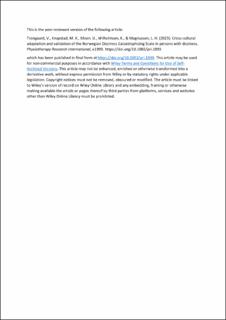| dc.description.abstract | Background and Purpose
Dizziness Catastrophizing Scale (DCS) is a questionnaire covering catastrophizing thoughts related to dizziness. The aims of this study were to cross-culturally adapt the DCS into Norwegian (DCS-N) and to examine the internal consistency, content and construct validity, and test-retest reliability of the instrument.
Method
Patients (18–67 years) with long-term dizziness were recruited from an ear, nose, and throat (ENT) clinic in Western Norway. Validity of the DCS-N was assessed by evaluating data quality (missing, floor and ceiling effects), content validity (relevance, comprehensiveness, and comprehensibility), structural validity (principal component analysis), internal consistency (Cronbach's alpha), and construct validity (predefined hypotheses). Test-retest reliability was examined by intraclass correlation coefficient (ICC1.1), standard error of measurement (SEM), smallest detectable change (SDC), and limits of agreement.
Results
In total, 97 women and 53 men, mean age (SD) 46.5 (12.7) with dizziness were included (in the study). A subgroup of 44 patients participated in test-retest assessment. Overall, the DCS-N was easy to comprehend. The principal component analysis supported a one-factor solution and internal consistency was satisfactory (α 0.93). Construct validity was acceptable; all the predefined hypotheses were confirmed. Test-retest reliability demonstrated ICC1.1 of 0.90 and a SEM of 4.9. SDC was estimated to be ±13.6.
Discussion
The DCS-N demonstrated acceptable measurement properties for assessing catastrophizing thoughts in patients with long-term dizziness. Further studies should examine the responsiveness of the DCS-N and a factor analysis should be undertaken in a larger population. | en_US |
